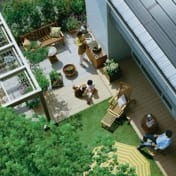Management's Message

Representative Director
of the Board, CEO
President, Executive Officer
Yoshihiro Nakai
The Sekisui House Group Continues
Creating Unique Value through Innovation
and Communication
For over 60 years, the Sekisui House Group has been pursuing new ways to create value in the housing domain, steadily building upon our achievements. Now, with colleagues who share our ambitions and passions, we have entered into a new stage of growth. We will continue to strive for unique value creation that we can proudly share with the world through continuous innovation and challenges.
Witnessing Exciting Progress
In 2018, we adopted “Innovation and Communication” as our slogan for internal transformation. Five years have passed since then, and I am pleased to witness a steady increase in exciting proposals and unprecedented ideas.
From my own experience, I am convinced that the seeds of innovation lie within our employees, who are constantly thinking about our customers’ happiness and staying vigilant. To nurture these seeds of innovation, it is crucial to have supervisors and colleagues who communicate effectively. We chose this slogan because we believe that when autonomous employees, who take independent and proactive actions and express their unique sense of beauty and individuality, come together, they spark new ideas and create remarkable value.
I have consistently communicated the importance of “Innovation and Communication”, “autonomy”, and “sense of beauty” in my own words in various contexts. I am confident that these principles have firmly been embraced by our employees, and I eagerly look forward to the new and innovative ideas they will bring.
Redefining Our Unique Identity
At the core of all business activities of the Sekisui House Group lies our fundamental Corporate Philosophy, “Love of Humanity,” which focuses on wishing for the happiness of others. Building on this foundation, we launched a new phase in 2020 by setting our Global Vision, “Make Home the Happiest Place in the World.” To achieve this vision, we have established “SEKISUI HOUSE-SHIP.”
SEKISUI HOUSE_SHIP
Creating new value through innovation.
Fostering ideas through effective communication and collaboration.
Taking proactive and independent action.
Continually refining our technology and sense of beauty.
Committing as professionals to making home the happiest place in the world.
I would like to share my thoughts and elaborate on “SEKISUI HOUSE-SHIP”. Our Global Vision embodies our desire to be a group that creates happiness. This means creating new values for a new era, focusing on the true happiness of the world beyond a mature and aging society.
For us to accomplish this, the Sekisui House Group itself must first change. While firmly upholding our Corporate Philosophy, we need a guiding principle to create further value. We have therefore redefined our identity, introducing it as “SEKISUI HOUSE-SHIP.”
SEKISUI HOUSE-SHIP encapsulates our desire to be an organization of individuals who share this mindset. During periods of high economic growth, following instructions from senior management and conforming to the company’s directions might have been sufficient to achieve steady growth. However, in today’s rapidly changing environment, it is increasingly important for employees to take independent and proactive action in their respective positions, sharing ideas based on their own senses and aesthetic judgments.
Our employees are the primary drivers of new value creation at the Sekisui House Group. Through “SEKISUI HOUSE-SHIP,” we will align our efforts and continue to create unique value.
Rooting Our Mission in Timeless Values
We have been researching housing for over 60 years. Sekisui House was founded to address the housing shortage while protecting people’s lives and property. This mission is especially important in Japan, where the country frequently experiences natural disasters, such as earthquakes and significant seasonal weather changes.
Although the housing shortage in Japan has been resolved, approximately five million out of the 29.2 million detached houses do not meet current earthquake resistance standards. Additionally, 89% of houses do not meet current energy efficiency standards. While the market for new houses in Japan is projected to contract partly due to population decline, these issues indicate that our founding mission remains unfulfilled.
I firmly believe that housing is a vital form of social asset. Therefore, it must be well-maintained and managed, retain long-term value, and be aesthetically pleasing.
When determining our priorities to fulfill our founding mission, we recognized the importance of leveraging our unique technologies and high-precision construction capabilities developed over many years. In September 2023, we launched the industry’s first joint construction project, the Skeleton and Infill (SI) business, by sharing our original seismic resistance technologies. This initiative aims to enhance the seismic performance of wooden houses across Japan in collaboration with Sekisui House Construction and external partners. By April 2024, we had formed partnerships with five companies to accelerate efforts in creating high-quality housing stock.
In addition to creating high-quality housing stock, we have set contributing to a sustainable society and promoting diversity and inclusion as our material issues. I believe these material issues aimed at achieving a sustainable future are not merely short-term goals; they are grounded in our enduring values and a require long-term commitment over the next 50 to 100 years.
Embracing Our “Love of Humanity” Legacy
What are the enduring values and purpose of our Group? I believe they are deeply embedded in our Corporate Philosophy, “Love of Humanity,” meaning wishing for the happiness of others, making their joy our own, and acting with integrity in the spirit of service. As a business leader, this Corporate Philosophy is a crucial guiding principle in my decision-making process, whether it involves establishing our vision, developing strategies, or strengthening governance.
Recently, I have often been asked, “Why do you go to such lengths to put the customer first?” While it has always been part of our DNA, I would like to take this opportunity to share my perspective on this in more detail.
As previously mentioned, Sekisui House was founded on the strong desire to protect people’s lives and their property. I believe this is why the spirit of “Love of Humanity,” which focuses on the happiness of our customers, has been a core value and passed down since our founding. This commitment is also reflected in our business model, where 98% of the homes we deliver are custom-built. From the start, we have designed each home to meet the specific needs of our customers and have committed to providing lifetime support. I am convinced that this approach has naturally ingrained a strong customer-first DNA in us.
Our commitment to our customers’ happiness is evident in the dedication of our employees and the craftsmen of the Sekisui House Association, who support our highest quality standards. Especially during natural disasters, these individuals are the first to think of our customers’ safety and act voluntarily, even without specific direction from the Company. Their actions serve as powerful examples of our core values in practice.
These enduring values and purpose, which have been passed down through our long history, will continue to guide us. We are committed to carrying them forward without losing sight of them.
Creating New Values in Housing
The journey of value creation at the Sekisui House Group can be divided into three phases.
In the first phase, from 1960 to 1990, we focused on researching and enhancing seismic resistance, durability, fire resistance, and shock resistance, providing the value of safety and peace of mind to our customers.
In the second phase, from 1990 to 2020, we concentrated on improving thermal insulation and incorporating universal design to consider everyone from children to the elderly, providing the value of comfort and environmental consideration to our customers.
In the third phase, starting in 2020, we have focused on creating happiness in homes, aligned with our Global Vision, “Make Home the Happiest Place in the World.” We broke down the concept of “happiness” for people living long lives, spanning 100 years, into three key elements: health, connectedness, and learning. For example, we envision homes that manage health conditions, connect with places such as grandparents’ homes, hospitals, and museums, and offer lifelong learning opportunities from the comfort of home. Although this is a highly challenging endeavor, it is one that only we can pursue thanks to our extensive experience and accumulated efforts in developing technologies for safety and peace of mind, as well as our lifestyle design proposals for comfortable and environmentally considerate living. Our plan is to gradually integrate new services and ideas throughout this third phase.
Ascending Steadily with the Sixth Mid-Term Management Plan
It has been one year since we launched the Sixth Mid-Term Management Plan (FY2023–FY2025), focusing on stable growth in Japan and proactive growth overseas. Our business performance in the first year has exceeded expectations, and we are effectively delivering new value globally. This is my sincere evaluation of our current situation.
In the domestic detached housing sector, we introduced a new design system, called “life knit design,” which is being implemented nationwide to better reflect residents’ sense of beauty in their homes. In rental housing, we have focused on promoting Sha Masion ZEH, with the ratio of ZEH housing orders surpassing our fiscal year goal of 70%. Additionally, our digital technology initiative for rental housing, “rental housing DX,” has achieved 100% online rental applications. The increase in self-guided tours of rental properties has further enhanced tenant convenience.
In our U.S. homebuilding business, we completed the acquisition of American homebuilder M.D.C. Holdings, Inc. in April 2024. This acquisition positions us to achieve our goal of supplying 10,000 single-family homes overseas, matching our domestic scale, ahead of schedule by the final year of the Sixth Mid-Term Management Plan in FY2025.
Since entering the U.S. homebuilding market in 2017, our primary objective for overseas M&A has been to transfer Sekisui House technologies and establish them as the global standard. In welcoming M.D.C. Holdings, Inc. to our Group, we prioritized aligning our values on construction philosophy, along with our commitment and passion for supplying high-quality housing.
The U.S. single-family housing market has been experiencing a chronic supply shortage due to high mortgage interest rates and rising construction costs. Additionally, there is an increasing demand for high-quality housing both in the U.S. and globally.
As a pioneer in homebuilding, our mission is to revolutionize the future of housing by providing highly durable and comfortable homes. We are committed to transferring our technologies, with the belief that they will set a new global standard in the housing industry. We will continue to expand proactively overseas, leveraging the strong governance and reliable business platform that M.D.C. Holdings, Inc. has developed over its 50-year history.
Unveiling New Values in New Markets
By welcoming M.D.C. Holdings, Inc. to the Sekisui House Group, we have expanded our presence in the U.S. from eight states to 16. In the U.S., building codes, market demands, and climatic conditions vary significantly by state. This expansion presents us with 16 unique challenges, but it also opens up 16 remarkable opportunities for our Group.
As we expand into the U.S. market, I believe in the concept of “planned happenstance”, or intentional coincidence. This idea emphasizes the importance of being open to unexpected opportunities. While I cannot foresee all the value that will emerge from introducing our advanced technologies to the U.S., the journey of discovering and implementing these innovations is an exciting marketing challenge. I am thrilled by the new possibilities we will uncover along the way.
Reflecting on my career, it has been a journey marked by intentional coincidences. While I followed a certain plan, unexpected encounters and events provided invaluable opportunities for growth. I discovered that what might at first seem like mere coincidences could actually result from being open to new experiences, guiding us toward unforeseen paths.
This approach might seem somewhat optimistic. Of course, detailed planning and preparation are essential in corporate management. However, I believe it is equally important to remain flexible and embrace the unexpected opportunities that may arise.
Pioneering New Value Through ESG Management
In Value Report 2023, I talked about our long-standing initiatives such as Net Zero Energy House (ZEH) and the Gohon no Ki Project. These efforts are integral to our mission of becoming a leading company in ESG management.
In FY2023, the CDP, which evaluates corporate environmental sustainability, awarded us an A rating in climate change, forestry, and water security. This “Triple A” rating highlights our leadership in transparency and performance.
We are the first company in the domestic housing and construction industry to achieve this Triple A rating. This honor reflects our continuous efforts to collaborate with customers and deepen our understanding of environmental challenges.
This year, I would like to highlight our efforts to promote women’s participation in the workplace.
I hold great confidence and pride in all of our Group’s female employees. In 2006, we established the Diversity Development Team and started actively recruiting female sales representatives. For the past two decades, promoting women’s participation has been a cornerstone of our business strategy. As of the end of January 2024, 29.4% of our employees were women, nearly double the industry average of 15.3% in the broader construction sector.
This journey has had its challenges. Initially, we faced many resignations and issues such as difficult working environments, long working hours, and a lack of understanding from supervisors. We identified the root causes of these issues, and with feedback from employees, implemented the working environment and related programs. As a result, we have created a more inclusive workplace and transformed programs to benefit all employees, regardless of gender.
Every year, I personally participate in conferences and award ceremonies for our female sales representatives, engaging in direct dialogue with them. It is truly heartening to see female employees who joined our Group after 2006 now thriving in managerial positions. While it is generally believed that women’s interest in managerial positions is declining, I am glad to see our female employees voluntarily participate in training for female managerial candidates. This enthusiasm is a testament to the growth of independent and proactive women within our Group. Additionally, our FY2023 Well-Being Survey revealed that the well-being score is notably high for female managers and their departments.
Recently, the representation of women in corporate officer and managerial positions has gained importance. However, rather than blindly chasing numbers, I aspire to naturally increase the ratio of managers by honoring their personal goals and nurturing their self-directed career development.
Creating Value with Our Team
Our Group’s fundamental philosophy on maximizing human capital value is encapsulated in “Employee Autonomy x Alignment of Efforts.” This concept is rooted in the belief that when each employee’s autonomy is aligned with the organization’s direction, we can achieve the highest human capital value and foster organizational growth.
I am often asked about the meaning of “autonomy.” My answer is very simple. Autonomy means choosing your own path and taking responsibility for your decisions. This is not limited to career development; it also includes decisions such as taking long vacations to spend time with family or shortening working hours for caregiving responsibilities. These are all admirable examples of autonomy, and we are dedicated to improving programs and environments to support every decision. We pledge unwavering support to all employees who strive for greater autonomy.
There are various definitions of “sense of beauty,” a concept highly valued by our Group. Personally, I believe it means capturing beauty and joy through one’s own senses. To nurture this sense of beauty, it might be beneficial to frequently encounter things that move your heart and captivate your senses. In an era of AI and technological advancements, I believe it is more important than ever to cherish moments that touch our hearts.
On April 1, 2024, our Group joyfully hosted a welcome party for 950 new graduates. While the term “company induction ceremony” may sound formal, we chose to call it a “welcome party” to warmly embrace our new colleagues. We continue to welcome new colleagues with similar motivations and passions, both domestically and internationally, as seen with our inclusion of M.D.C. Holdings.
In the past, we have sent onsite supervisors and craftsmen from Japan to Australia to implement Sekisui House technologies. We plan to undertake similar initiatives in the United States. I am confident that enhancing opportunities for collaboration between colleagues from different countries will foster greater innovation and communication.
Sharing Unique Values Found Nowhere Else
As we continue our journey, I am reminded of an important realization. Our Group’s unwavering commitment to our customers’ happiness and relentless dedication to housing research have endowed us with technologies and expertise that are truly unique in the world.
The Sekisui House Association, which I previously mentioned, includes approximately 5,000 carpenters dedicated to our housing construction business. These professional carpenters, bound by strong ties and mutual trust built over many years, possess exceptional craftsmanship. They are true masters of their craft, adhering to the highest construction standards and rigorous quality inspections. In November 2023, we held the Sekisui House Carpentry Competition, WAZA 2023, where these carpenters showcased their extraordinary skills. We express our heartfelt gratitude and respect to these dedicated craftsmen who play a key role in creating happiness for our customers. We also aim to maximize their annual income.
In addition to our core competencies in technical expertise, construction capabilities, and customer base, we have cultivated a wealth of philosophies and a culture rooted in an unwavering commitment to always putting the customer first. These unique values, carefully built over six decades, represent a value found nowhere else in the world.
It has been three years since we released our first Value Report in 2022. Our Value Report is more than just a display of figures and performance results; it serves as a vital tool to clearly convey our values and deepen our connection with all stakeholders.
The challenges, successes, and even failures we have encountered over the years are invaluable assets to our Group. By actively sharing the unique values we have cultivated through our journey, we aim to design a happier future with all of you.
Japan is one of the first countries in the world to transition into a mature and super-aged society. By fully leveraging our unique values, we are aligning our efforts to create a happy and prosperous future.
Please look forward to the Sekisui House Group’s continued journey of creating unique value by further advancing innovation and communication.



